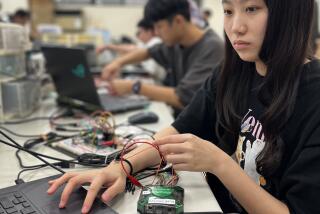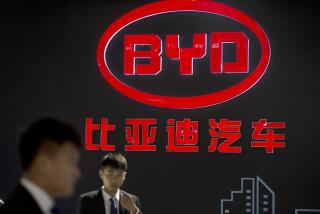Taiwan Semiconductor Firms’ Expansion Into China Poses a Dilemma
- Share via
TAIPEI, Taiwan — For Taiwan’s large and growing semiconductor industry, the future could hardly look brighter.
Already a major world producer, its state-of-the-art silicon chip factories sit barely 100 miles across the Taiwan Strait from China, the biggest emerging high-tech market anywhere--a market with which it shares a common language, culture and heritage.
Adding to the rosy picture is the prospect that many of the trade barriers between the two uneasy political rivals will fall when both become members of the World Trade Organization, which is likely to happen this year.
The reaction of Taiwan’s government to all this: gloom, hand-wringing and a planning paralysis that combine to conceal a deepening sense of foreboding.
The reason for this worry is not hard to explain. Taiwan’s political leaders are afraid that conditions across the strait might be too good for their semiconductor sector--so good, in fact, that Beijing might be able to suck the entire sector right out from under them.
What especially worries policymakers in Taipei is that the loss of the country’s important semiconductor and other high-tech production would not just be an economic calamity but a political one too. They believe that it would give Beijing added leverage in its efforts to reunify the island with the Communist-controlled mainland and that Taiwan’s very existence as an independent, democratic political entity could be seriously jeopardized.
“Our economy could be vacuumed out by the mainland market, and our sovereignty would go with it,” declared Andrew Yang, director general of the Chinese Council of Advanced Policy Studies, an independent political think tank in Taipei. “It’s a bitter pill.”
Although Taiwan’s chip producers have been caught in the global downdraft of demand that has affected manufacturers everywhere, analysts who track industry trends believe that the present market weakness probably will have little effect on the migration of companies toward the mainland.
Because Taiwan’s chip makers constitute the largest single source of supply for many of the major American chip designers, the United States also has a stake in the industry’s fate.
Among the recent developments in the semiconductor migration across the Taiwan Strait:
* Taiwanese entrepreneur Winston Wong has teamed up with a mainland counterpart named Jiang Mianheng, the son of Chinese President Jiang Zemin, to invest $1.6 billion in a plant now under construction in Shanghai that will produce 50,000 8-inch silicon chips per month.
“The goal is to start primary production by the third quarter of next year,” said Tim Juang, a senior vice president at Wong’s Grace THW Group.
* Successful Taiwanese high-tech industry executive Richard Chang has staked his future on the mainland after selling his Taiwan-based company, Worldwide Semiconductor Manufacturing Corp., last year. His new, $1.4-billion Shanghai-based venture, Semiconductor Manufacturing International Corp., is expected to begin pilot production of 8-inch silicon chips later this year.
Although Semiconductor Manufacturing’s production target of 30,000 wafers per month is less than that of the Wong-Jiang venture, Chang’s experience in the industry and his ability to take much of his old design team with him from Taiwan make him a more formidable competitor, according to analysts monitoring the development.
* A group of Taiwanese engineer-investors has banded together with large mainland steel producer Shougang in a $1-billion-plus venture based in Beijing called Huaxia Semiconductor Manufacturing Co. that could start production of 8-inch silicon wafers by 2003.
* Drawn by the large supply of readily available design engineers on the mainland, one of Taiwan’s premier chip design houses, Via Technologies, reportedly has plans to establish a research and development center there sometime this year.
“Via isn’t the only one,” said Chitung Liu, who tracks the industry for UBS Warburg in Taipei. “These design houses don’t like to advertise they are over there, but they are. They see no sense in drawing the [Taiwan] government’s attention, and they don’t want the competition to know either.”
Taiwan’s two biggest chip producers, Taiwan Semiconductor Manufacturing Corp. and United Microelectronics Corp., say they see no immediate need to go to the mainland, maintaining that conditions there can’t yet support the state-of-the-art production of 12-inch silicon chips they presently turn out. But there is little doubt they will eventually go too.
“In three to five years, I think the situation in China will have improved to such an extent that we will want to set up there,” Taiwan Semiconductor Chairman Morris Chang said in an interview.
For those in Taiwan’s government responsible for the island’s economic and political future, the developments are disturbing. Like decision makers in many smaller nations, they find themselves powerless to stem the currents of an increasingly globalized world.
Taiwan’s restrictive policies on commercial investment in China don’t appear to be working. Government rules restricting Taiwan producers from making any chip on the mainland larger than 6 inches, for example, are easily circumvented by funneling the investment through third parties in third countries. Dollar investment limits can be ignored in the same way.
Aware that blocking industries that compete globally from more competitive locations also is no answer, senior government officials say they plan to adjust future restrictions in consultation with industry leaders.
Other policies aimed at reducing the mainland’s influence in Taiwan actually encourage industry’s flight. At a time when Taiwan has a severe shortage of skilled engineers, for example, the government refuses to recognize professional degrees earned by its citizens at mainland universities. And hiring workers from the mainland frequently becomes a bureaucratic nightmare, industry sources complain.
Such problems merely make a labor-rich mainland location more attractive.
Ing-wen Tsai, chairwoman of the Taipei-based Mainland Affairs Council, admitted that the government did not fully understand the industry it was trying to contain.
“The civil service is structured in a way that we just cannot get people to join the government who are familiar with the market,” she said. “We don’t have enough people in government who have a good assessment of the . . . market risks involved in a particular policy, therefore we tend to be too conservative.
“It’s a big challenge for us,” she said.
But even if the talent were there to come up with a new vision, it would be tough to implement because diplomatic contacts across the Taiwan Strait have been frozen for nearly two years, observers note.
Seemingly bereft of alternatives, Taiwan’s leaders cling doggedly to their existing strategy amid a deepening gloom.
During the course of an hourlong interview, the chairman of Taiwan’s Council for Economic Planning and Development, Po-chih Chen, sketched out a doomsday scenario that ended with a hollowed-out economy, declining wages and rising unemployment.
“We hope it won’t happen that way, but it could,” he said.
Not everyone is so pessimistic.
Many familiar with Taiwan’s semiconductor industry believe that low-tech silicon chip production is likely to migrate to the mainland, but that Taiwan, with its undisputed edge in production technology, could become an even more important global player, gradually transforming itself into a high-end research and development center.
“If they [China] work very hard, they can close the gap in semiconductor technology,” said Chang of Taiwan Semiconductor. “The gap will become smaller, but it will be very hard for them to close it completely.”
Noted a Western resident of Taipei familiar with the debate: “The same worries haunted policymakers in the United States in the late 1980s as high-tech production began moving offshore, but the result was that it turned the U.S. into an innovative machine.”
Others say the verdict is still out.
“In the next five years, the research and development will be done here,” Liu of UBS Warburg said. “Beyond that, it’s hard to say what’s going to happen.”
But he predicts that Taiwan’s new high-tech industrial park in the southern coastal city of Tainan will have a tough time competing against Shanghai.
“I think more people will opt for Shanghai,” he said. “The [skilled] people are there; the infrastructure is there. The pace of improvement is incredible. Every year it gets better.”






